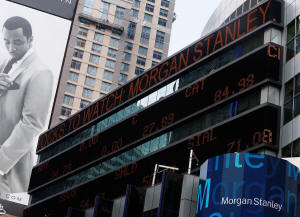Wall Street gets creative as regulators demand more capital
 Send a link to a friend
Send a link to a friend
 [November 27, 2023] By
Shankar Ramakrishnan [November 27, 2023] By
Shankar Ramakrishnan
(Reuters) - Earlier this fall, Morgan Stanley bought $300 million worth
of protection against losses on some of its loans from Blackstone Group
and other investors, two sources familiar with the matter said.
The transaction, details of which have not been previously reported, was
effectively insurance, structured as a sale of bonds called
credit-linked notes, according to the sources and regulatory filings.
By transferring the risk to investors, the $1.4 trillion asset bank
could reduce the amount of capital it has to hold against those loans to
cover for potential losses.
Morgan Stanley and Blackstone declined to comment.
The deal is one of several such credit risk transfer transactions that
U.S. banks are considering in the aftermath of a March crisis in the
sector and as regulators look to increase capital they have to hold,
bankers, lawyers and investors said.
Interviews with eight people involved in the deals show different forms
of credit-linked notes and insurance contracts are being discussed to
free up precious capital.
While it is known that banks have been looking to offload risk through
such transactions, these interviews offer new details on the types of
deals and their terms, providing a rare window into a market that's
shrouded in secrecy.

These deals help banks meet capital requirements more efficiently,
allowing them to keep lucrative businesses that would otherwise become
unprofitable.
But they come with risks. Investors in these deals include
lightly-regulated entities like hedge funds, shifting risk to the shadow
banking sector. That raises the prospect that regulators will have less
visibility and understanding of the dangers that lurk in the financial
system. The ability to shed the risk could also encourage banks to get
more aggressive on lending, leading to problems later.
"If a bank didn't manage interest rate risk well, does it appreciate
potential risks associated with these transactions?" said Jill Cetina,
associate managing director at Moody’s. "It raises the need for better
and more fulsome disclosure in banks' regulatory filings."
Over the last few months, banks including JPMorgan Chase, Merchants Bank
of Indiana and US Bancorp, have sold the risk of losses on billions of
dollars of loans for cars, multi-family homes, private funds, junk-rated
companies, commercial equipment and consumers, these industry sources
said.
Jon-Claude Zucconi, head of tactical situations at Apollo's ATLAS, which
structures such deals, said many U.S. banks are setting up programs to
issue credit linked notes for the first time.
He expects U.S. banks to sell the risk on nearly $100 billion of assets
over the next 12 months, freeing up nearly $15 billion of equity
capital. Investors get yields ranging from 8% to 15% from such
transactions, Zucconi said.
JPMorgan and US Bancorp declined to comment, while Merchants Bank did
not respond to requests for comment.
Wall Street's financial engineering is causing concerns among some
lawmakers and regulators. The Federal Reserve approved the Morgan
Stanley transaction in late September but set limits, including on size,
and is watching closely.

"If they perform as intended, then they might be more generally
available," said Fed Vice Chair for Supervision Michael Barr in
Congressional testimony this month. "If we see risks arising in those
transactions, then we would limit their use for capital mitigation."
SIGNIFICANT INCREASE
The surge in interest in these transactions comes after regulators, led
by Barr, proposed capital requirements earlier this year that were
tougher than what banks had hoped.
Smaller banks not affected by the proposal have also been looking at
these deals as a way to free up capital as conditions tightened after
the regional banking crisis.
"Banks are spending a lot of time on their loan books and figuring out
how to optimize what they have," said Missy Dolski, global head of
capital markets at Varde Partners, which invests in such transactions.
[to top of second column] |

The Morgan Stanley worldwide headquarters building is pictured in
New York June 22, 2012. REUTERS/Brendan McDermid

Some banks have sold loan portfolios, businesses and cut down their
lending, which were not optimal strategies because it reduces their
market share and competitiveness, said Sam Graziano, managing
director at advisory firm Chatham Financial.
Some considered raising capital by selling shares and preferred
equity but it was expensive due to low stock valuations and high
interest rates, Graziano said.
Credit risk transfer is another tool for them to pursue after the
Fed’s clarification on what is allowed, said Cory Wishengrad, head
of fixed income at Guggenheim Securities.
Jed Miller, a partner at Cadwalader, Wickersham & Taft, said often
these transactions were structured so that proceeds must be retained
by the bank on deposit for the life of the trade. The upfront cash
gave Fed comfort in Morgan Stanley's case, according to Barr's
testimony.
DIFFERENT DEALS
Credit risk transfers are common in Europe, where banks transfer the
loans to off-balance sheet entities, called special purpose vehicles
(SPVs), before selling the risk on those loans. Those deals are
called synthetic credit linked notes. But SPVs can come with tax and
other complexities.
Morgan Stanley's transaction kept the loans, a portfolio of
revolving credit lines to private funds, called subscription lines,
on its balance sheet, according to the sources and the regulatory
filing.
U.S. Bank followed up with a similar deal in late October and
received approval from the Fed last week for a similar transaction,
according to sources and a regulatory filing.
Reuters could not determine why Morgan Stanley and U.S. Bank chose
to do a direct credit linked note rather than a synthetic one.
Other U.S. banks have been opting for synthetic deals. One of the
earlier ones this year was done by Merchants Bank, an Indiana-based
lender with $16 billion in assets. The details of its structure shed
light on how these deals work.

Merchants priced a $158.14 million credit-linked note on March 24,
providing credit protection on some commercial mortgages, including
loans to nursing and assisted-living facilities, the deal's terms
show. The transaction freed up Merchant's capital, allowing it to
use it to make new loans.
Through the trade, the bank would absorb the first 1% of losses on
the portfolio, while the next 14% would be absorbed by investors,
according to the term sheet. That means Merchants sold the riskiest
tranche of the loan portfolio, maximizing the capital relief it
could get on it.
The investors deposited cash in a collateral account as protection
to Merchants Bank, the term sheet shows.
Merchants did not respond to requests for comment.
Then last month, JPMorgan did one of the largest trades of this
kind. It placed synthetic credit linked notes for $2.5 billion with
investors, three sources said. They referenced a pool of mortgages
and loans totaling about $20 billion, the sources said.
Deborah Staudinger, banking and loan finance partner at Hogan
Lovells, said banks are also considering transactions to lower risk
on a single loan or a portfolio by buying insurance.
The deals, which are yet to happen, can be secured by cash or other
collateral posted by one or more insurers. Whether U.S. regulators
will allow such insurance deals to qualify for capital relief is
still untested, Staudinger said.
(Reporting by Shankar Ramakrishnan; Editing by Paritosh Bansal and
Nick Zieminski)
[© 2023 Thomson Reuters. All rights
reserved.]
This material may not be published,
broadcast, rewritten or redistributed.
Thompson Reuters is solely responsible for this content.
 |